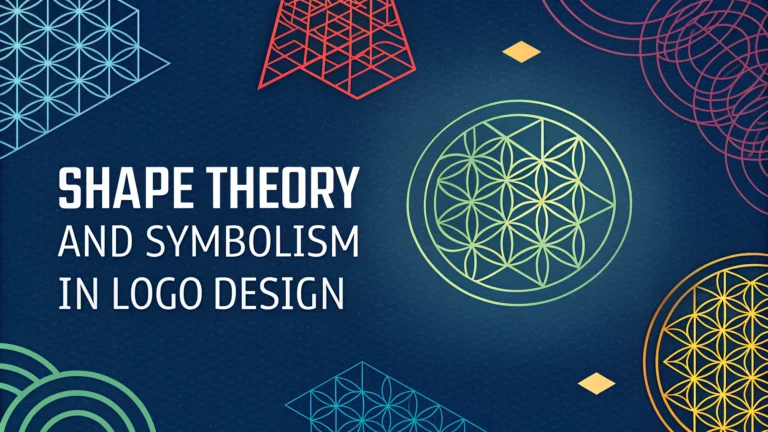Shapes carry deep psychological meanings that influence how people perceive and remember logos.
Circles suggest unity, harmony, and completeness – think of masterpieces like the Nike swoosh or Target’s bullseye.
Squares and rectangles communicate stability and reliability, which explains their popularity in corporate logos like Microsoft and American Express.
Triangles point upward to convey growth and direction, as seen in logos like Google Play and Delta Airlines.
Basic Shape Psychology in Logo Design:
- Circles: Community, friendship, love, unity
- Squares: Professionalism, efficiency, balance
- Triangles: Power, science, religion, law
- Spirals: Growth, evolution, creativity
- Horizontal Lines: Tranquility, calmness
- Vertical Lines: Strength, aggression
Practical Applications:
| Industry | Recommended Shapes | Examples |
|---|---|---|
| Technology | Squares, Circles | IBM, Apple |
| Finance | Squares, Triangles | Chase, Citibank |
| Healthcare | Circles, Crosses | Red Cross, Blue Cross |
The negative space between shapes can create memorable secondary images, like the arrow in FedEx’s logo.
Tips for Shape Selection:
- Research your industry’s common shape patterns
- Test your logo at different sizes
- Consider cultural implications of shapes
- Maintain simplicity – avoid using more than 2-3 basic shapes
- Ensure shapes work in both color and monochrome
Color psychology works hand-in-hand with shape theory – for example, red circles suggest energy while blue squares communicate trust.
Simple geometric shapes often resonate better with audiences than complex designs.
Test your logo designs with user testing platforms to validate shape choices.
Common Shape Mistakes to Avoid:
- Overcomplicated combinations of shapes
- Ignoring industry standards completely
- Using shapes that don’t scale well
- Forgetting to check cultural meanings
Contact professional logo designers through platforms like Behance or Dribbble for expert guidance.
Advanced Shape Considerations
Shape combinations can create powerful visual hierarchies and enhance brand recognition when used strategically.
The psychology of shape intersections adds complexity to logo design – overlapping circles suggest collaboration, while intersecting squares can represent partnership.
Shape Dynamics in Modern Design:
- Gradients: Add depth to basic shapes
- Broken Shapes: Suggest innovation and disruption
- Organic Shapes: Connect with nature and authenticity
- Geometric Patterns: Create visual interest and texture
Digital Adaptation:
| Platform | Shape Considerations | Best Practices |
|---|---|---|
| Social Media | Square-friendly designs | Simple, bold shapes |
| Mobile Apps | Circular icons | Clear silhouettes |
| Websites | Responsive shapes | Scalable vectors |
Conclusion
Understanding shape psychology is crucial for creating effective logo designs that resonate with target audiences and stand the test of time.
Successful logos balance traditional shape meanings with contemporary design trends while maintaining brand relevance across various platforms and contexts.
Final Considerations:
- Always prioritize shape clarity over complexity
- Consider how shapes will evolve with your brand
- Test shapes across different mediums and backgrounds
- Document your shape choices for brand consistency
FAQs
- What role do basic shapes play in logo design?
Basic shapes communicate fundamental psychological messages – circles suggest unity and harmony, squares represent stability and reliability, triangles imply direction and dynamism. These shapes form the foundation of effective logo design and instantly trigger subconscious associations in viewers. - Why is negative space important in logo design?
Negative space creates clever dual imagery, adds visual interest, and helps achieve balance in logo design. Famous examples include the FedEx arrow and the WWF panda, where negative space becomes an integral part of the design’s meaning. - How does color psychology influence logo design?
Colors evoke specific emotions and associations – red suggests energy and passion, blue conveys trust and professionalism, green represents growth and nature. Color choice significantly impacts brand perception and should align with the brand’s values and industry. - What makes a logo design timeless?
Timeless logos typically feature simple shapes, minimal colors, clear typography, and avoid trendy elements. They focus on core brand values rather than current design fads, ensuring longevity and consistent recognition. - How does symbolism affect brand recognition?
Symbolic elements in logos create immediate associations and improve brand recall. Cultural and universal symbols can transcend language barriers and communicate complex brand messages instantly. - What is the golden ratio in logo design?
The golden ratio (1:1.618) is a mathematical principle used to create aesthetically pleasing and balanced logos. Many successful logos, including Apple and Twitter, incorporate this ratio in their proportions. - How important is scalability in logo design?
Scalability is crucial as logos must maintain clarity and impact across various sizes and applications, from business cards to billboards. Simple shapes and clean lines ensure better scalability. - What role does typography play in logo design?
Typography communicates brand personality and affects readability. Font choice can convey traditional values, modernity, luxury, or approachability, making it a crucial element in logo design. - How do cultural differences affect logo symbolism?
Symbols can have different meanings across cultures. Successful global logos consider cultural sensitivities and universal interpretations to avoid miscommunication or offense. - What is the relationship between shape hierarchy and visual impact?
Shape hierarchy determines how viewers process logo elements. Primary shapes draw initial attention, while secondary elements support the main message, creating an organized visual journey through the design.







